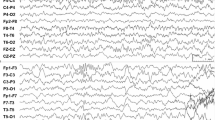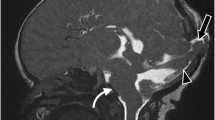Abstract
The case of a 15-year-old right-handed girl with developmental delay, mild retardation, astereognosis, and tactile discrimination impairment in the left arm, is reported. During sleep, right partial simple motor seizures with sialorrhea and saliva pooling were present, sometimes followed by secondary generalization. Absences and drop attacks were also observed. Electroencephalography revealed left centrotemporal spike waves spreading to the homologous contralateral region, generalized 3-Hz spike-and-wave complexes enhanced by hyperventilation, and generalized polyspike-and-wave discharges during drowsiness. Magnetic resonance imaging showed right perisylvian (opercular) malformation. Benign epilepsy of childhood with centrotemporal spikes (BECCTS) is a focal idiopathic epilepsy presumed to be of genetic origin. Although brain damage is not expected, structural lesions including opercular macrogyria have been reported. This coexistence has been considered mainly casual and only exceptionally causal. The Foix-Chavany-Marie syndrome or operculum syndrome is the result of bilateral opercular damage. In our child the right structural and the left functional lesions appeared mutually activated, yielding a transient opercular syndrome. The concomitance of BECCTS and developmental opercular dysplasia is suggestive of a common genetic substratum.
Similar content being viewed by others
References
Aicardi J, Chevrie JJ (1982) Atypical benign partial epilepsy of childhood. Dev Med Child Neurol 24:281–292
Ambrosetto G (1992) Unilateral opercular macrogyria and benign childhood epilepsy with centrotemporal (rolandic) spikes: report of a case. Epilepsia 33:499–503
Andermann F, Olivier A, Melanson D, Robitaille Y (1987) Epilepsy due to focal cortical dysplasia with macrogyria and the forme fruste of tuberous sclerosis: study of 15 patients. In: Wolf P, Dam M, Janz J, Dreifuss E (eds) Advances in epileptology, vol 16. Raven Press, New York, pp 35–38
Beaumanoir A, Ballis T, Varfis G, Ansari K (1974) Benign epilepsy of childhood with rolandic spikes. Epilepsia 15:301–315
Becker PS, Dixon AM, Troncoso JC (1989) Bilateral opercular polymicrogyria. Ann Neurol 25:90–92
Bruyn GW, Gathier JC (1969) The operculum syndrome. In: Vinken PJ, Bruyn GW (eds) Handbook of clinical neurology, vol 2. North-Holland, Amsterdam, pp 776–783
Colamaria V, Sgrò V, Caraballo R, Simcone M, Zullini E, Fontana E, Zanetti R, Grimau-Merino R, Dalla Bernardina B (1991) Status epilepticus in benign rolandic epilepsy manifesting as anterior operculum syndrome. Epilepsia 32:329–334
Dalla Bernardina B, Tassinari CA (1975) EEG of a nocturnal seizure in a patient with “benign epilepsy of childhood with rolandic spikes”. Epilepsia 16:497–501
Doose H, Bayer WK (1989) Benign partial epilepsy and related conditions: multifactorial pathogenesis with hereditary impairment of brain maturation. Eur J Pediatr 149:152–158
Foix C, Chavany JA, Marie J (1926) Diplégie facio-linguo-masticatrice d'origine cortico-souscortical sans paralysie des membres. Rev Neurol 33:214–219
Fusco L, Vigevano F (1991) Reversible operculum syndrome caused by progressive epilepsia partialis continua in a child with left hemimegalencephaly. J Neurol Neurosurg Psychiatry 54: 556–558
Graff-Radford NR, Bosh EP, Stears JC, Tranel D (1986) Developmental Foix-Chavany-Marie syndrome in identical twins. Ann Neurol 20: 632–635
Guerrini R, Dravet C, Raybaud C, Roger J, Bureau M, Battaglia A, Livet MO, Colicchio G, Robain G, Robain O (1992) Neurological findings and seizure outcome in children with bilateral opercular macrogyric-like changes detected by MRI. Dev Med Child Neurol 34:694–705
Heijbel J, Blom S, Rasmuson M (1975) Benign epilepsy of childhood with centrotemporal EEG foci: a genetic study. Epilepsia 16:285–293
Kanazawa O, Kaway I (1990) Status epilepticus characterized by repetitive asymmetrical atonia: two cases accompanied by partial seizures. Epilepsia 31:536–543
Kuzniecky R, Andermann F, Tampieri D, Melanson D, Olivier A, Leppik I (1989) Bilateral central macrogyria: epilepsy, pseudobulbar palsy, and mental retardation. A recognizable neuronal migration disorder. Ann Neurol 25:547–554
Moodley M, Bamber S (1990) The operculum syndrome: an unusual complication of tuberculous meningitis. Dev Med Child Neurol 32: 919–922
Musumeci SA, Ferri R, Elia M, Colognola RM, Bergonzi P, Tassinari CA (1991) Epilepsy and fragile X syndrome: a follow-up study. Am J Med Genet 38:511–513
Pazzaglia P, D'Alessandro R, Ambrosetto G, Lugaresi E (1985) Drop attacks: an ominous change in the evolution of partial epilepsy. Neurology 35:1725–1730
Prats JM, Garaizar C, Uterga JM, Urroz MJ (1992) Operculum syndrome in childhood: a rare cause of persistent speech disturbance. Dev Med Child Neurol 34:359–364
Roulet E, Deonna T, Despland PA (1989) Prolonged intermittent drooling and oromotor dyspraxia in benign childhood epilepsy with centrotemporal spikes. Epilepsia 30:564–568
Santanelli P, Bureau M, Magaudda A, Gobbi G, Roger J (1989) Benign partial epilepsy with centrotemporal (or rolandic) spikes and brain lesion. Epilepsia 30:182–188
Shevell MI, Carmant L, Meagher-Villemure K (1992) Developmental bilateral perisylvian dysplasia. Pediatr Neurol 8:299–302
Tatum WO, Coker SB, Ghobrial M, Abd-Allah S (1989) The open opercular sign: diagnosis and significance. Ann Neurol 25:196–199
Author information
Authors and Affiliations
Rights and permissions
About this article
Cite this article
Iannetti, P., Raucci, U., Basile, L.A. et al. Benign epilepsy of childhood with centrotemporal spikes and unilateral developmental opercular dysplasia. Child's Nerv Syst 10, 264–269 (1994). https://doi.org/10.1007/BF00301166
Received:
Issue Date:
DOI: https://doi.org/10.1007/BF00301166




